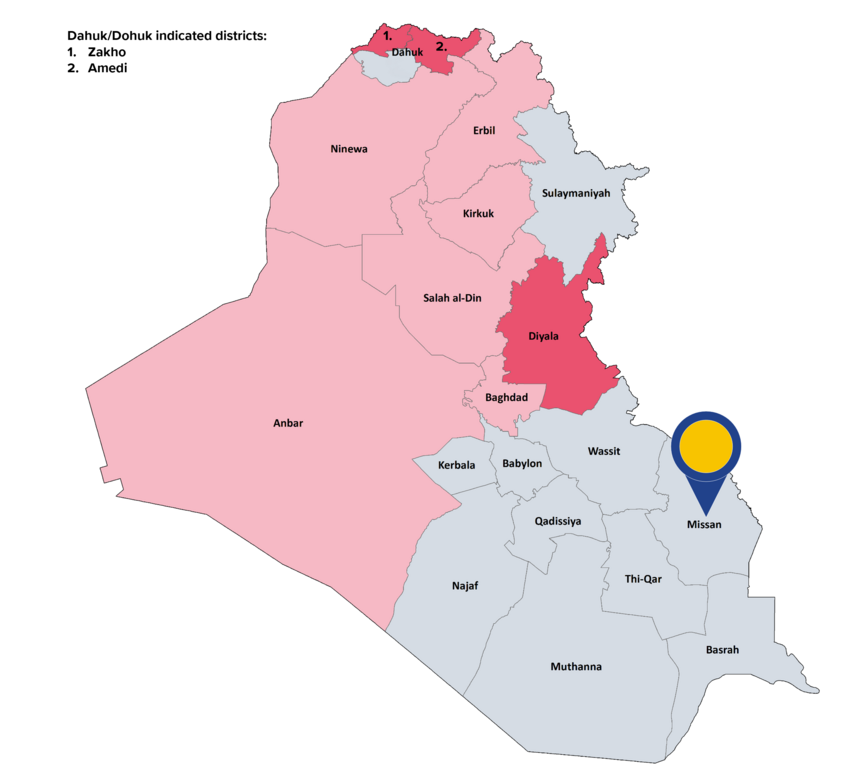COMMON ANALYSIS
Last update: June 2022
General information
Missan governorate is located in southeast Iraq and borders Wassit, Basrah and Dhi Qar governorates, and Iran to the east. The governorate is divided in into six districts: Ali Al-Gharbi, Al-Mejar Al-Kabir, Al-Maimouna, Al-Kahla, Amarah and Qal’at Saleh. The capital is Amarah. The Iraqi CSO estimated the governorate’s population for 2021 at 1 202 175, with the vast majority being Shia Arabs. Missan was once known as an agricultural and industrial centre. However, deteriorating environmental conditions caused people to abandon agriculture and engage in daily wage labour, leading to displacement and sparking conflicts between tribes over livelihoods and resources.
Background of the conflict
Since 2008, Missan has been a relatively calm governorate and was not among the regions taken by ISIL in 2014. Tribal affiliations played into inter-Shia fighting, frequently resulting in armed confrontations, such as between the Sadrist group Saraya Al-Salam and members of Asa’ib Ahl Al-Haq in the context of the nationwide protests in October 2019. Clashes also involved Shia militias confronting coalition and security forces. Tribal disputes were another reason for violent clashes and killings in Missan.
Protests that erupted in October 2019 with Amarah as the main arena within Missan continued in the governorate in 2020 and 2021. Protests in June and July 2021 resulted in confrontation between protesters and security forces.
Actors: control and presence
Missan governorate is under the control of ISF. The ISF units in Missan consisted of the Sumer Operations Command (SuOC) that replaced the Al-Rafidain Operations Command (ROC), the Command Brigade, emergency regiments, local police, and a Federal Police brigade. The army forces handed over the security file in Missan to the police command.
Presence of PMF was also reported. The Ansar Allah Al-Awfiya controls important government offices and businesses. The armed group is a component of the PMF faction Asa’ib Ahl Al-Haq. Both are reportedly loyal to Iran. In addition, smaller armed factions (e.g. Ansar Al-Aqeedah, Harakat Al Nujaba, Sayyid Al-Shuhada) were present in Missan. The nominal PMF director of intelligence in Basrah is allegedly playing an important role in hosting and training foreign fighters, running what is believed to be the largest Iran-backed training site in Kumayt in Missan governorate.
Nature of violence and examples of incidents
Deadly clashes between drug dealing gangs and security forces have reportedly occurred on transportation routes as well as in urban settings in the context of smuggling and drug dealing in Missan. Repeated deadly clashes between tribal factions also occurred. In addition, tribal elements have retaliated against Iran-backed groups in Missan and other regions.
Incidents: data
In the reference period, ACLED reported a total of 85 security incidents (average of 1.3 security incidents per week) in Missan of which 39 incidents were coded as violence against civilians, 36 as battles and 10 as remote violence/explosions. UNAMI[36] recorded no armed conflict-related incidents from 1st August to 31 December 2020 and 4 armed conflict-related incidents from 1st January until 31 October 2021 (average of 0.1 security incidents for the full reference period).
Geographical scope
While all Missan’s districts were affected by security incidents, The majority of them were recorded in Al-Kahla district.
Civilian casualties: data
In the reference period, UNAMI recorded 7 casualties (5 death and 2 injured) in the aforementioned armed conflict-related incidents. More specifically, they all occurred from 1st January until 31 October 2021. Compared to the official figures for the population in the governorate, this represents 1 civilian casualty per 100 000 inhabitants for the reference period.
Displacement
As of 30 September 2021, 1 974 IDPs were registered in Missan. The IDP population is largely concentrated in the district of Amarah (81 %). No IDPs originating from Missan were registered in other parts of the country and no returns to Missan were documented.
Further impact on civilians
UNDP reported in February 2018 that infrastructures were mostly functioning in all of Missan’s districts. However, road damages reportedly concerned all districts and, particularly, Amarah. In Amarah, schools, youth centres, fire stations and markets were also damaged or malfunctioning.
On 2 January 2021, an alleged leftover landmine from the Iraq-Iran war period exploded in Missan’s Al-Tayeb area near the border with Iran, killing two civilians and injuring one other. At the end of 2020, a total of 795 825 square metres were still contaminated by cluster munition in Missan.
|
|
Looking at the indicators, it can be concluded that in the governorate of Missan there is, in general, no real risk for a civilian to be personally affected within the meaning of Article 15(c) QD. |
Main COI references: Security 2022, 2.13

[36] UNAMI data focuses on armed conflict-related incidents, which have directly impacted civilians (causing civilian casualties) and the civilian nature of property and protected areas (such as civilian houses, cropland, schools, health facilities and mosque), see ‘Indicators of indiscriminate violence, number of incidents’.
